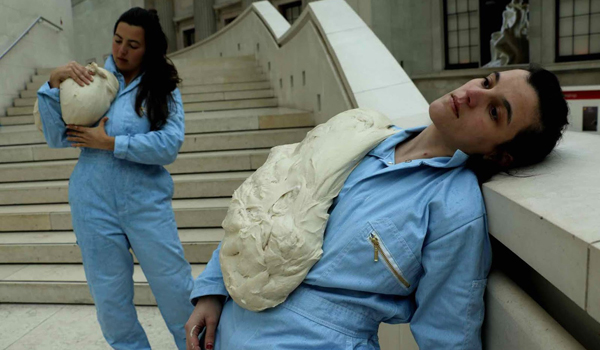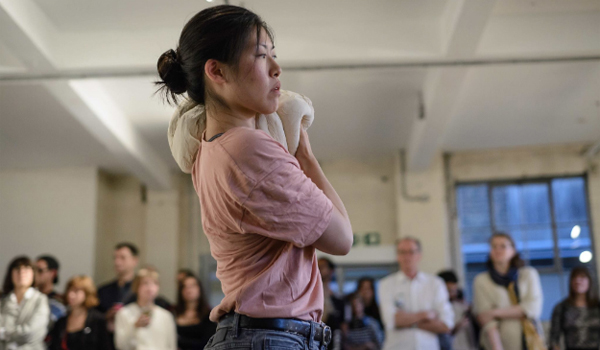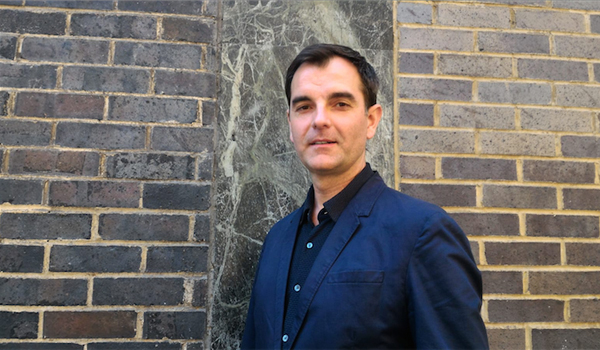Photograph: Franck Bordese, Impresario
Franck Bordese is a freelance Impresario and Executive Director at Protein Dance. He has been invited, along with Block Universe, to commission a new performance work as part of the ‘Rodin and the art of ancient Greece’ exhibition at The British Museum. He has worked extensively in dance, theatre, performance; and on this occasion re-connects with artist Laura Wilson for a one-off durational performance in The British Museum’s Great Court. Independent Curator and Director at Frith Street Gallery Dr. Ali MacGilp asks him about his career, his views on performance today and his forthcoming projects.
Ali MacGilp: You are curating Laura Wilson’s first solo presentation at a UK museum You would almost expect to find it warm at the British Museum as part of this year’s Block Universe festival. Could you tell me a little about this project and how the collaboration came about?
Franck Bordese: Laura and I go way back. When I worked at Siobhan Davies Studios I invited her to have an exhibition. The result was amazing and Laura created a monumental performance on an adjacent tower. Upon my return to London early 2017, I started a conversation with The British Museum about a project called SOMA, which I am still working on. When the museum started working on the programme for the exhibition Rodin and the art of ancient Greece, they approached me to curate a performance in response to the exhibition. Laura was an obvious choice. The museum wanted to work with Block Universe, so we decided to all work together. I could not have hoped for a better partnership. Laura had started working with bread dough. The connection between marble and dough seemed obvious to me. Somehow it also convinced The British Museum and Block Universe, and off we went.
Ali: In her practice, Laura Wilson frequently collaborates with specialists to create performative sculptural works that illuminate the relationship between materiality, memory and tacit or experiential knowledge. For this durational performance at the British Museum, she places six performers and six large balls of fresh dough side by side; these two kinds of living organisms will be in a constant flow of movement while providing a dynamic view of a mostly inanimate object that has uncanny resemblance to marble and to human flesh. This new commission seems to me to be the perfect apotheosis of a long-term strand of Wilson’s practice investigating bread, our deceptively simple daily staple. Wilson’s use of the dough and performers connects the Elgin Marbles of the British Museum Parthenon Collection and Rodin’s figures. At first glance the relationship between Wilson’s work and Rodin seems unlikely. Could you expand on this unusual pairing? What do you imagine the affect will be on the audience?
Franck: I knew that Rodin never actually carved his sculptures, preferring to model them from clay. When purchased the sculpture is then carved by Rodin’s studio from marble, or cast in bronze according the wish of the commissioner. Similarly, the Greek marbles where carved following the sculptor Phidias’ instructions. Where Rodin’s work retains a certain roughness in its appearance, the Greek marbles have a perfect polish that give them an ethereal feel. I started to imagine what it could be like for Rodin to model with a clay-like marble. That is when I realised that Laura’s bread dough which she used as sculpture could be this ‘liquid’ marble. The dough has the colour of blond marble, it also has the appearance and the folding properties of human skin. It has the inertia, elasticity and liveliness of human flesh, while being cold to the touch.
Both Rodin and Phidias sculpted the human body, so the presence of people was important for this new commission, and Laura created a performance for six performers and six large balls of bread dough. They each move with and in response to each other. Like a sculpture that slows time, dough moves very slowly, in turn making the audience take time to look; look at the performers’ bodies and look at this moving marble. The Greek marbles are contemporary works, they are of today, they bear the marks of the centuries that have passed over them, and gently they evolve. That movement intrigued Rodin, and he created works that are in the becoming. I would hope that this performance, as well as giving us new information about how we construct ourselves in response to the material that we surround ourselves with, will also suggest a different way of looking at sculpture.

Photograph: You would almost expect to find it warm by Laura Wilson
Ali: I love that you describe yourself as an Impresario. Such a great job title, so much more evocative than the now banal curator! What was your personal route into this role? How do you define your responsibilities in the relationship with an artist when you develop a new commission?
Franck: My second lawyer in New York got me an O1 visa as Impresario, I guess I liked it. In the UK, the Impresario instigates and organises arts events, in France, where I am from, they are more like artists’ agents. I feel I am both. For some artists I help them like an agent does, for others I make events happen. As for curator, the only collection I have is my own, and I am happy to be its curator, but I don’t ‘curate’ it outside my place.
My work consists of finding and sometimes creating an environment that encourages the connection between the artist, the art and the audience. I also work on extending the life of a work by developing new opportunities for it to be seen. It’s a team work with the artist; I trust we make a good team. This takes respect and awareness as well as admiration. I need to be in a state of seduction to work with someone.
Ali: You have held central roles in a number of innovative arts organisations including South London Gallery, Hoxton Hall, Protein Dance, Siobhan Davies Dance and Performa (NYC). How do you view the overlap between the contemporary art and performing art worlds? What developments have you seen over the course of your career to date?
Franck: First of all, I have always worked across both fields, and I am equally comfortable working with a dance artist, a musician or a visual artist. At one level the ‘overlap’ is rather seamless. Many dancers, work with visual artists – this is the case with Laura for her new work at The British Museum; and visual artists have been invited into the theatre. In recent years more galleries and museums have embraced dance.
Dance artists, such as the modern American choreographers have had close personal links with the visual arts, but it was mainly personal links, not so much institutional relationships. Now this has changed and major museums present dance exhibitions, some more timidly than others. These events have built on the growing connections between art forms, and artists, programmers and curators are learning each-others’ language. Curators are learning that performers do eat, need rest, go to the bathroom, something that was not so obvious only 15-years ago. Choreographers and theatre producers are getting more at ease with museum directors.
To me, one of the key barriers to a more productive collaboration is first of all education and secondly the question of collecting or ‘selling’ performance work by performance artists, choreographers, or dance artists – work that involves the body of the artist. When the public purse gets more and more squeezed and artists are asked to secure private funding for their work, the idea of improving one’s status as collector and increasing the value of one’s collection are intimately connected to your giving, even if that is true, philanthropy remains an act that provides a joy that no ‘profit’ can match. In an age when data is the new capital, art – be it of visual or performing nature – will have an even greater part to play, and maybe we will not have to worry so much about this overlap anymore.

Photograph: You would almost expect to find it warm by Laura Wilson
Ali: You are interested in how the history of human knowledge is written in our own bodies. This performance is part of a larger research project you are developing entitled SOMA. What does this word mean for you? I understand these are a series of commissions that seek to introduce the human body into museums’ archeological and historical collections in order to reveal how our body has played a part in our becoming what we are today. Could you tell me more? Is there a political dimension to this research given the current climate?
Franck: After years of working in dance in galleries and in theatres, working in theatres putting on plays, music, dance and cabaret, I came to understand that what fascinates me is the performer. The artist as the art. I have also always enjoyed learning through history, I studied comparative history of law. Socially, history is sometimes frustrating particularly when looking at the current political landscape, do we as a species ever learn from history, or at least recent history? It gradually became clear that what was missing from the museum is us. It seems so simple and yet, the constant element that unites all the collections through time and place is the human body. Our DNA has been shaped by history and it is now proved that it retains physical as well as emotional information. SOMA will give people an experience of the archaeological collection and will also unpack the collections that are within our body, tens of thousands of years of accumulations of movement, visual information and connections, because our bodies are our living museum.
SOMA will be able to travel freely across borders, transcend ideologies and give us new ways of looking at each other – not so much through what we produce, but for what we are. In that sense SOMA might have a political dimension.
Ali: You have spoken of our bodies as our living museum. I find this idea very beautiful and moving. What is your next project, the next chapter of this research?
Franck: I am still working on SOMA, talking to archaeologists, scientists and artists. The next stage is to find a way to communicate this to a large public. I was at The British Museum one day and was listening to a presentation by a Museum Guide. A man was standing nearby and was clearly not interested, waiting for his friends, checking his phone. At some point the Museum Guide mentioned a piece that had been discovered in Wales. Our man put away his phone, his face became alert and he turned to the Guide and told him that he too was from Wales and started asking questions about the object. He had found a reason to connect. I want SOMA to have this effect on everyone. We all look for ourselves: we are actually everywhere, but we need a way to see it.
Franck Bordese
Dr. Ali MacGilp
laurawilson.me
You would almost expect to find it warm
by Laura Wilson
Site-specific commission by Franck Bordese in partnership with Block Universe.
Friday, 1 June 2018, 4pm – 8pm (durational)
British Museum, Great Russell St, Bloomsbury, London WC1B 3DG, UK
This is a public event, no booking necessary.
britishmuseum.org
blockuniverse.co.uk
